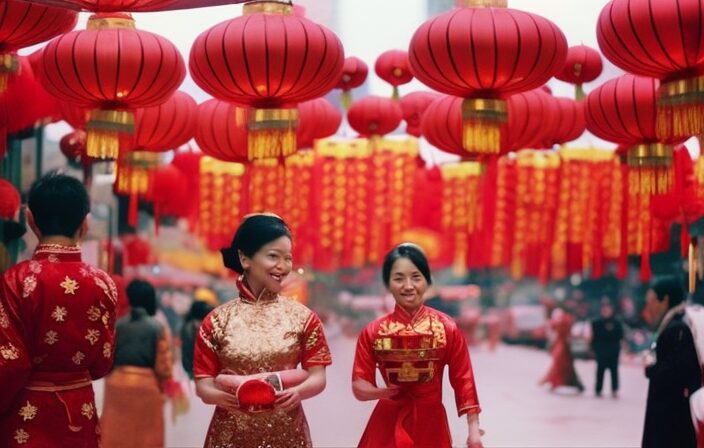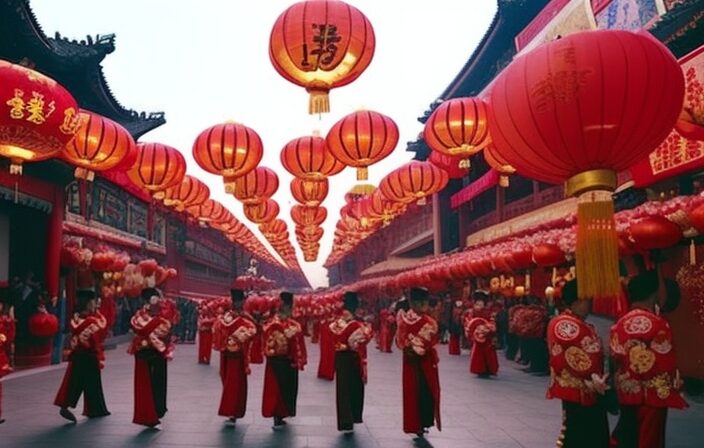According to recent data, Lunar New Year, also known as Spring Festival, is celebrated by over 1.5 billion people worldwide, making it one of the most significant cultural events of the year.
This auspicious occasion holds deep historical and cultural significance, with traditions and symbolism that vary across different regions.
From vibrant parades and traditional feasts to the exchange of red envelopes, Lunar New Year festivities have not only gained popularity in Asia but also in Western countries, reflecting its global influence and appeal.
Key Takeaways
- Lunar New Year can be traced back several thousand years to ancient China and is celebrated by Chinese communities worldwide.
- The festival has evolved over time with the influence of Confucianism and Buddhism, but its origins were in honoring ancestors and deities.
- Lunar New Year is celebrated with symbolic foods, traditional clothing, lion and dragon dances, and fireworks to ward off evil spirits.
- The celebrations vary across Asia, with unique customs and traditions in countries like South Korea and Vietnam, and are also gaining popularity in Western countries with street parades, cultural performances, and food festivals.
The Origins and History of Lunar New Year
The origins and history of Lunar New Year can be traced back several thousand years to ancient China. The festival, also known as Spring Festival or Chinese New Year, marks the beginning of the lunar calendar and is celebrated by Chinese communities around the world.
The history of Lunar New Year dates back to the Shang Dynasty (1600–1046 BCE), where it was observed as a way to honor ancestors and deities. The festival was traditionally celebrated with grand feasts, fireworks, and performances to ward off evil spirits and bring good luck for the coming year.
Over time, Lunar New Year evolved and incorporated various cultural practices and customs. The influence of Confucianism and Buddhism introduced rituals such as ancestor worship, temple visits, and the offering of incense. During the Tang Dynasty (618–907 CE), the festival became an occasion for imperial ceremonies, with the Emperor performing rituals to pray for a prosperous year.
As Chinese communities migrated and settled in different parts of the world, the celebration of Lunar New Year spread, adapting to local customs and traditions. Today, Lunar New Year is celebrated not only in China but also in countries with significant Chinese populations, including Taiwan, Hong Kong, Singapore, and various Chinatowns across the globe.
The origins and history of Lunar New Year highlight its cultural significance and enduring influence. The festival continues to be a cherished tradition, symbolizing renewal, unity, and the hope for a prosperous year ahead.
Symbolism and Traditions of Lunar New Year
Symbolism and traditions play a significant role in the observance of this important cultural festival. Lunar New Year is rich in symbolism, with various customs and practices that are deeply rooted in history and culture. Here are four examples of how symbolism and traditions are manifested during the Lunar New Year celebration:
-
Symbolic Foods: During Lunar New Year, certain foods are prepared and consumed because they are believed to bring good luck and prosperity. For example, dumplings symbolize wealth and prosperity because their shape resembles ancient Chinese gold and silver ingots. Fish represents abundance and prosperity, while oranges symbolize good fortune and wealth.
-
Traditional Clothing: One of the most visible aspects of Lunar New Year celebrations is the traditional clothing worn by people. In Chinese culture, the color red is considered lucky and is often worn during this festive period. Traditional outfits such as the cheongsam for women and the changshan for men are worn to pay homage to the customs and traditions of the past.
-
Lion and Dragon Dances: Another important tradition during Lunar New Year is the lion and dragon dances. These dynamic performances are believed to ward off evil spirits and bring good luck for the coming year. The lion dance involves performers dressed in a lion costume, while the dragon dance features a long dragon made of fabric and bamboo. The dances are accompanied by loud drumming and cymbal crashing, creating a vibrant and energetic atmosphere.
-
Fireworks and Firecrackers: Fireworks and firecrackers are an integral part of Lunar New Year celebrations. They are believed to scare away evil spirits and bring good luck for the upcoming year. The sound and spectacle of fireworks lighting up the night sky create a festive and joyful atmosphere for all to enjoy.
The symbolism and traditions associated with Lunar New Year reflect the values and beliefs of the culture, creating a deep sense of identity and unity among those who celebrate this auspicious occasion.
Lunar New Year Celebrations Across Asia
Across various countries in Asia, Lunar New Year is celebrated with unique customs and traditions that showcase the rich cultural diversity of the region. The cultural significance of Lunar New Year is immense, as it symbolizes the beginning of a new year according to the lunar calendar. Family gatherings are an integral part of this celebration, as it is believed to bring good luck and prosperity for the upcoming year.
In China, the Lunar New Year, also known as the Spring Festival, is the most important holiday. It is a time when families come together for a reunion dinner, where they enjoy traditional dishes and exchange gifts. The celebration extends for 15 days and includes activities such as lion and dragon dances, lantern festivals, and the famous fireworks displays.
In South Korea, Lunar New Year is called Seollal and is a time for families to pay respects to their ancestors. Traditional rituals are performed, such as bowing to elders and making offerings at ancestral graves. Families gather to share a meal of tteokguk, a rice cake soup that symbolizes good fortune and longevity.
In Vietnam, Lunar New Year is known as Tet and is celebrated with similar enthusiasm. The celebration includes visiting temples, exchanging lucky money, and enjoying special holiday foods like banh chung, a sticky rice cake. Family members come together to honor their ancestors and pray for a prosperous year ahead.
Overall, Lunar New Year celebrations across Asia highlight the importance of family and tradition. It is a time for people to come together, express gratitude, and wish for a prosperous year ahead. The customs and traditions associated with this festival reflect the cultural richness and diversity of the Asian region.
Lunar New Year Festivities in Western Countries
In Western countries, the festivities surrounding the Lunar New Year showcase the growing cultural exchange and appreciation for Asian traditions. As multicultural celebrations gain popularity, people from all backgrounds come together to honor this significant holiday.
Here are four aspects of Lunar New Year festivities in Western countries that highlight the cultural assimilation and multicultural celebrations:
-
Street Parades: Colorful processions fill the streets with vibrant lion and dragon dances. The rhythmic beat of drums and clashing cymbals create a lively atmosphere, attracting locals and tourists alike.
-
Traditional Performances: Theatrical shows featuring traditional music, dance, and martial arts captivate audiences. From acrobatic performances to traditional folk dances, these showcases provide a glimpse into the rich heritage of Asian cultures.
-
Food Festivals: Food plays a central role in Lunar New Year celebrations. Western cities organize food festivals where visitors can indulge in a wide array of Asian delicacies such as dumplings, spring rolls, and sticky rice cakes.
-
Cultural Workshops: Various community centers and organizations offer workshops that allow participants to learn about Asian customs and traditions. From calligraphy and lantern making to tea ceremonies, these interactive experiences foster cultural understanding and appreciation.
These multicultural celebrations demonstrate the embracing of Asian customs and traditions by Western societies, creating an environment of cultural exchange and unity.
The Global Impact and Growing Popularity of Lunar New Year
The increasing recognition and adoption of Lunar New Year festivities by countries around the world highlight the significance of this cultural event. The global recognition of Lunar New Year has grown significantly in recent years, with more and more countries embracing the traditions and celebrations associated with this important holiday. This global recognition not only showcases the cultural diversity and richness of the Lunar New Year, but also promotes cultural exchange and understanding among different nations.
Lunar New Year, also known as Chinese New Year or Spring Festival, is celebrated by millions of people around the world. Traditionally observed by Chinese communities, the festival has now expanded its reach and is celebrated by people from various cultural backgrounds. This growing global recognition is a testament to the cultural exchange that takes place during Lunar New Year festivities.
Countries around the world have embraced Lunar New Year as an opportunity to celebrate and appreciate Chinese culture. Festivals and parades showcasing lion dances, traditional music, and cultural performances have become common in many cities. The exchange of traditional gifts, such as red envelopes filled with money, has also become a popular practice during this time.
The global recognition of Lunar New Year highlights the importance of cultural diversity and encourages people to learn about and appreciate different cultures. It fosters a sense of unity and understanding among nations, promoting cultural exchange and strengthening global connections. As Lunar New Year continues to gain popularity worldwide, its celebrations serve as a bridge for cultural understanding and appreciation.
What Are Some Global Superstitions and Taboos During Lunar New Year?
During Lunar New Year, various countries have unique lunar new year traditions and beliefs, often accompanied by superstitions and taboos. In China, it is considered unlucky to sweep or clean on New Year’s Day, as it is believed to symbolize sweeping away good luck. In Korea, breaking bowls during the lunar new year feast is seen as fortuitous, signifying an abundance of wealth. Each culture embraces these intriguing customs to ensure good fortune and happiness throughout the year.
Conclusion
In conclusion, Lunar New Year is a significant cultural event celebrated by millions of people worldwide.
Its origins and history, as well as the symbolism and traditions associated with it, make it a unique and cherished holiday.
The celebrations of Lunar New Year can be witnessed across various Asian countries and have also gained popularity in Western countries.
As a testament to its global impact, a staggering 1.5 billion people around the world participate in Lunar New Year festivities, making it one of the most widely celebrated holidays globally.



